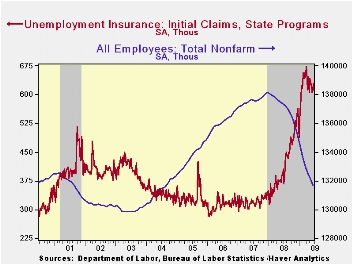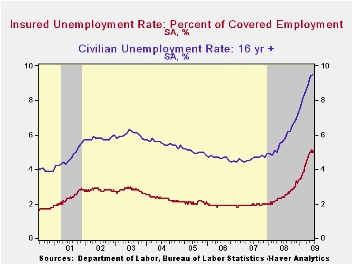 Global| Jul 06 2009
Global| Jul 06 2009U.S. Initial Unemployment Insurance Claims Continue To Move Sideways
by:Tom Moeller
|in:Economy in Brief
Summary
Despite the week-to-week gyration, initial claims for unemployment insurance have moved sideways since April, trending slightly downward. Reported Thursday, claims edged down last week by 16,000 to 614,000 after an upwardly revised [...]

Despite the week-to-week gyration, initial claims for unemployment insurance have moved sideways since April, trending slightly downward. Reported Thursday, claims edged down last week by 16,000 to 614,000 after an upwardly revised 18,000 increase during the week prior. The latest level was off from the March peak of 674,000. The four-week average of claims, which smoothes out some of the volatility in the weekly numbers, also fell slightly to 615,250 which was its lowest level since mid-February. The latest weekly level roughly matched Consensus expectations.
The Labor Department indicated that the largest increases in initial claims for the week ending June 20 were in California (+14,570), New Jersey (+3,170), Oregon (+3,062), Maryland (+2,342), and Michigan (+2,032), while the largest decreases were in Missouri (-5,753), Pennsylvania (-3,037), Texas (-2,759), Alabama (-1,926), and Florida (-1,894).
Also suggesting improvement in the job market was a 53,000 decline in continuing claims for unemployment insurance which reversed all of the prior week's gain. Weekly claims were down slightly from their May high. Continuing claims provide an indication of workers' ability to find employment. At 6,702,000, however, claims remained more than twice the year ago level. The four-week average of continuing claims again fell just slightly from their record high. The series dates back to 1966.
These improvements in the weekly claims figures have led to a leveling out of the insured unemployment rate. It slipped to 5.0% where it has been for the last seven weeks. Nevertheless, job market distress is evidenced by the fact that the level remained more than double that of June 2008 and the highest since 1983. During the last ten years there has been a 93% correlation between the level of the insured unemployment rate and the overall rate of unemployment published by the Bureau of Labor Statistics.
The highest insured unemployment rates in the week ending June 13 were in Michigan (7.5 percent), Oregon (6.7), Puerto Rico (6.6), Nevada (6.3), Pennsylvania (6.2), Wisconsin (5.7), California (5.4), South Carolina (5.3), Arkansas (5.2), Illinois (5.2), and North Carolina (5.2).
The unemployment insurance claims data is available in Haver's WEEKLY database and the state data is in the REGIONW database.
Reply to Generalizing the Taylor Principle: A Comment from the Federal Reserve Bank of Kansas City can be found here.
| Unemployment Insurance (000s) | 06/27/09 | 06/20/09 | 06/13/09 | Y/Y | 2008 | 2007 | 2006 |
|---|---|---|---|---|---|---|---|
| Initial Claims | 614 | 630 | 612 | 51.6% | 420 | 321 | 313 |
| Continuing Claims | -- | 6,702 | 6,755 | 112.6% | 3,342 | 2,552 | 2,459 |
Tom Moeller
AuthorMore in Author Profile »Prior to joining Haver Analytics in 2000, Mr. Moeller worked as the Economist at Chancellor Capital Management from 1985 to 1999. There, he developed comprehensive economic forecasts and interpreted economic data for equity and fixed income portfolio managers. Also at Chancellor, Mr. Moeller worked as an equity analyst and was responsible for researching and rating companies in the economically sensitive automobile and housing industries for investment in Chancellor’s equity portfolio. Prior to joining Chancellor, Mr. Moeller was an Economist at Citibank from 1979 to 1984. He also analyzed pricing behavior in the metals industry for the Council on Wage and Price Stability in Washington, D.C. In 1999, Mr. Moeller received the award for most accurate forecast from the Forecasters' Club of New York. From 1990 to 1992 he was President of the New York Association for Business Economists. Mr. Moeller earned an M.B.A. in Finance from Fordham University, where he graduated in 1987. He holds a Bachelor of Arts in Economics from George Washington University.






